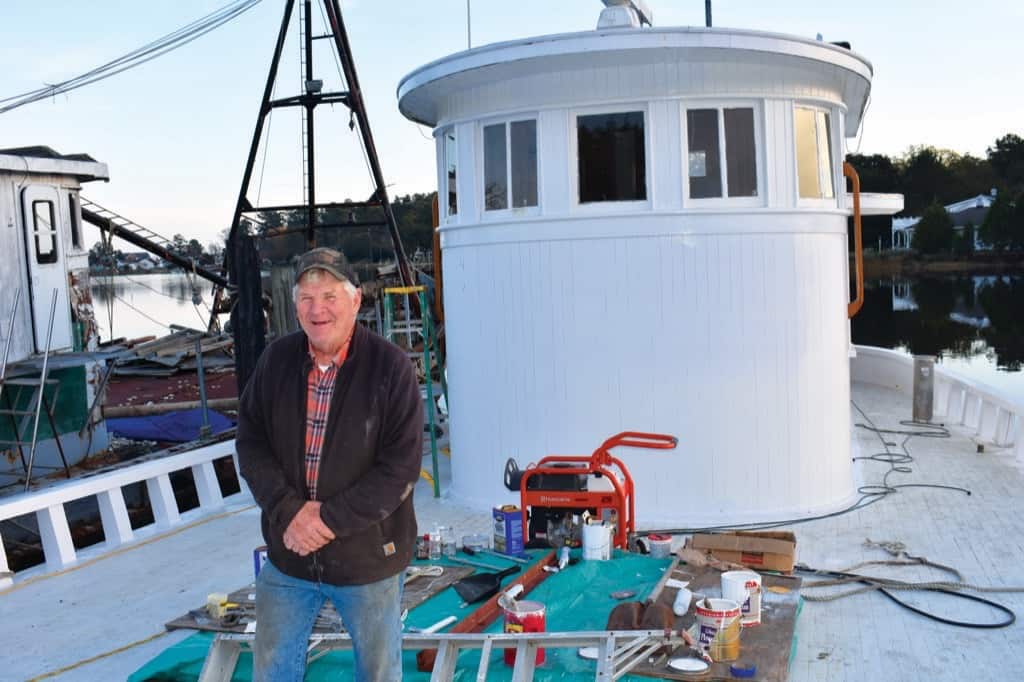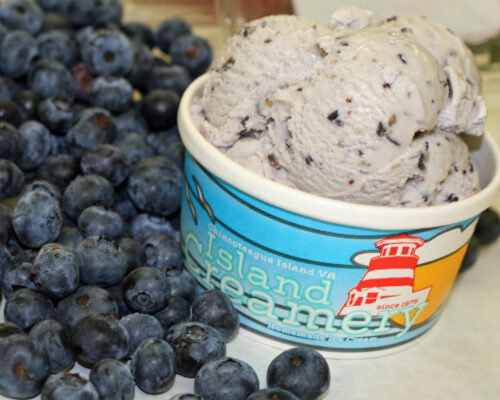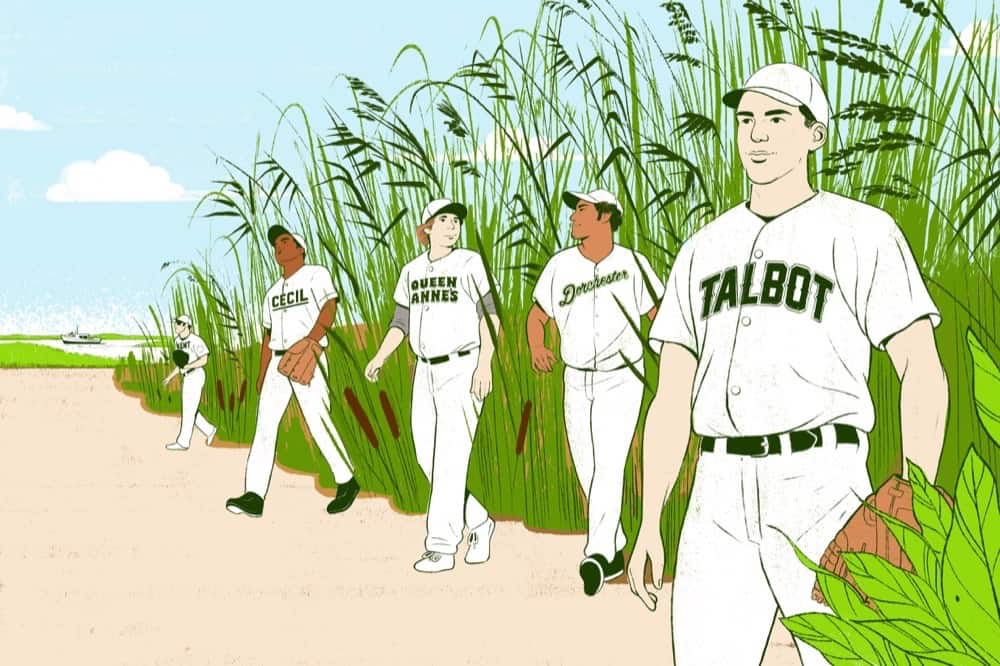An 80-foot Virginia buyboat finds new life in aquaculture.
The Beginning
Guinea Neck in Gloucester County is a peninsula tucked between the southwest branch of the Severn River, Mobjack Bay, and Sarah Creek on the York River. The boundaries are such that exactly where Guinea starts and stops depends on who you talk to.
Like Tangier and Smith Island watermen, Guinea’s commercial fishermen have a reputation for competence and independence. Richard Green, 74, recalls the days in the 1950s when the largest oyster boats on the Bay home-ported on Perrin Creek in Guinea. During the oyster planting seasons, the boats, loaded with mountains of oysters, regularly spent weekends moored at the public dock. While captains and mates were home, these unattended oyster boats became playgrounds. The boys raced to the top of the mounded oysters; sat in the helmsman’s seat with hands on the wheel of the 100-foot-long oyster buyboat Fisherman; and dreamed of being part of the working life on the boats.
Many captains of these giant buyboats were from Gloucester and Mathews counties. Jimmy Jones Belvin was the captain of the Fisherman, Luther Jenkins captained the Ocean View, and George Carmine the Mobjack, all from Guinea Neck. Morris Snow of Mathews County captained the mighty Chesapeake, which was over 100 feet long.
“What a sight it was when those boats were lined up with seed oysters mounded to what seemed like up to the sky,” said Green. “They looked like ships to us. When a 38-foot deadrise went by, it looked like a skiff up against those big boats.”
When he was 14 years old and sitting on the stern of Ocean View, Green told Captain Jenkins confidently that he would own the boat someday.
“My dream came true,” he said as he sat on the monkey rail of Mobjack at his dock in Perrin. “I own the Ocean View and I don’t know what I’m going to do with her.”
Much has changed since the 1950s when Virginia’s oyster business supported these giant vessels. Oyster diseases (MSX and dermo), hurricanes, over-fishing, and the loss of oyster habitat due to siltation and other factors brought Virginia’s oyster economy to its knees and left these giant boats without work.
The buyboat Chesapeake caught fire and sank in the Atlantic while ocean clamming. The Fisherman was abandoned and eventually hauled out into the Atlantic and sunk. Ocean View went to New Jersey to work in the clam and oyster fisheries, returning to the Bay in 2012, its wooden decks and hull encased in rusty steel. The Mobjack struggled, but fared better than the rest. She stayed on the Bay, and consecutive owners did all they could to keep her functional, or at least floating, for the next owner.
Five years ago, Mobjack went up for sale, and the timing was good, as Virginia’s oyster fishery was making a comeback. Green leases 2,000 acres of oyster ground on the James and York Rivers, and needed a boat like the Mobjack that could carry 3,000 bushels of seed oysters.
Mobjack could handle the work, but not without a major rebuild. The cost factor of rebuilding portions of an 80-foot wooden boat meant Green had to do most of the work himself with a few hired hands when necessary. Mobjack was in bad shape. Her keel, side and bottom planks, structural floor timbers, and the house and pilothouse were salvageable. The rest needed to be replaced with new wood.
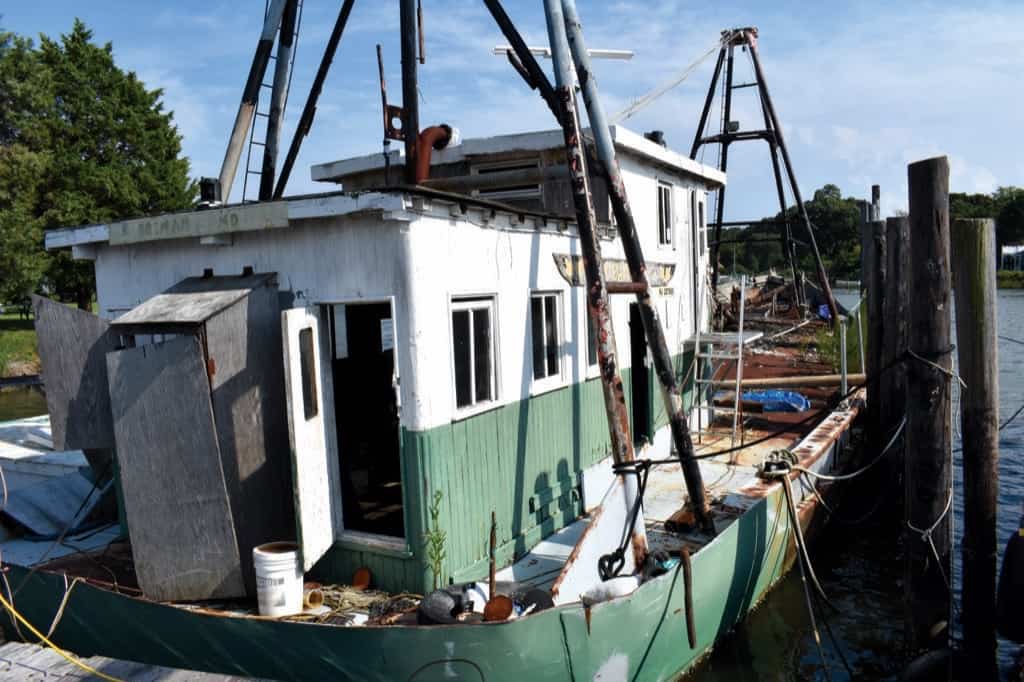
Boatbuilding Heritage
Green learned boatbuilding from his father and uncles. His father, Herman, built 28- to 30-foot deadrise workboats, and his uncle Melvin built flat-bottom and deadrise skiffs. Herman’s mother, Martha Ellen was sister to Frank Smith, who built 80-foot ocean trawlers and 65-foot buyboats boats at his boatyard, across from where Mobjack and Ocean View are moored today.
“My father built and rebuilt a lot of boats and I learned boatbuilding skills by hanging around my father and my uncle’s railway. Walter Brown also had a little railway on the creek where I was always welcome,” said Green. “I paid attention to the way those old-time builders built and repaired the boats, and that paid off when it came time for me to rebuild the Mobjack.”
Before taking on Mobjack, Green had built one boat. He launched the 50-foot God’s Grace in 2000 to work his oyster grounds. “She is the only one I ever built, but I think I did a good job,” he said. “She has been worked hard but has held up well.”
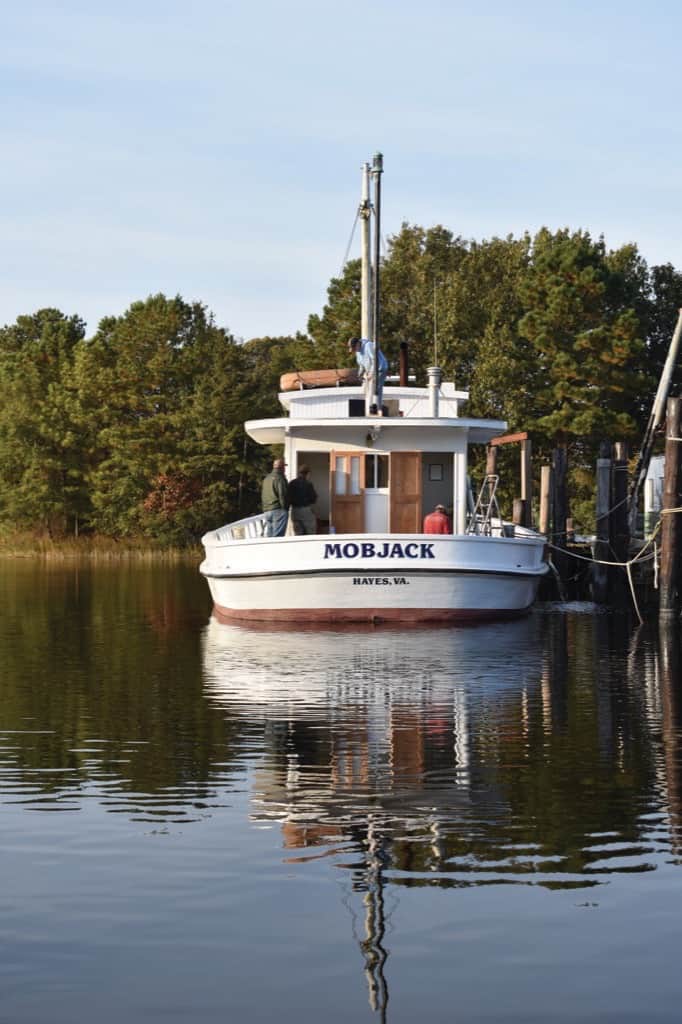
The Oyster Business
Green learned about the oyster business from his brother, Edward, who has since passed away. Green worked at and retired from the Norfolk Naval Shipyard in Portsmouth where he was a firemen at the shipyard’s fire station. Edward had carried on the family tradition of working the water and on days when Green was off work, he went with his brother and culled oysters. Edward hand tonged oysters in the York and James Rivers and sold his catch to oyster buyboats working those rivers.
The brothers worked the public oyster rocks on the two rivers but also explored areas no longer productive. This would eventually lead to the 2,000 acres of oyster rock that Green now leases from the state.
“We poked around looking for hard bottom to grow oysters on. When we found good bottom, I would check with Virginia Marine Resources Commission to see if the bottom was leased. If it wasn’t and it was good bottom, I would lease it.”
Virginia’s oyster harvest plummeted from four million bushels in the 1958-59 oyster season to 20,250 bushels in the 1997-98 season. As the business declined, Green speculated it would come back and he kept leasing oyster bottom. He was also able to buy up some of the better private oyster grounds on the James River from long-time planters who saw little future in hanging on to the bottom.
“You have got to be a gambler to be an oysterman,” said Green. “I figured if oysters came back and I had plenty of oyster ground, I would be in a good business position. No one had ever seen a slump like we saw in 1998, but there had been slumps before and oysters had always come back. I figured they would come back eventually.”
Several years ago, oysters began to rebound in Virginia waters. It was nothing like the days of four million bushels, but it rebounded to 635,164 in 2015-16 and over 500,000 bushels annually since. Five years ago, Green bought the Mobjack in an effort to further position himself if the business continued to rebound.
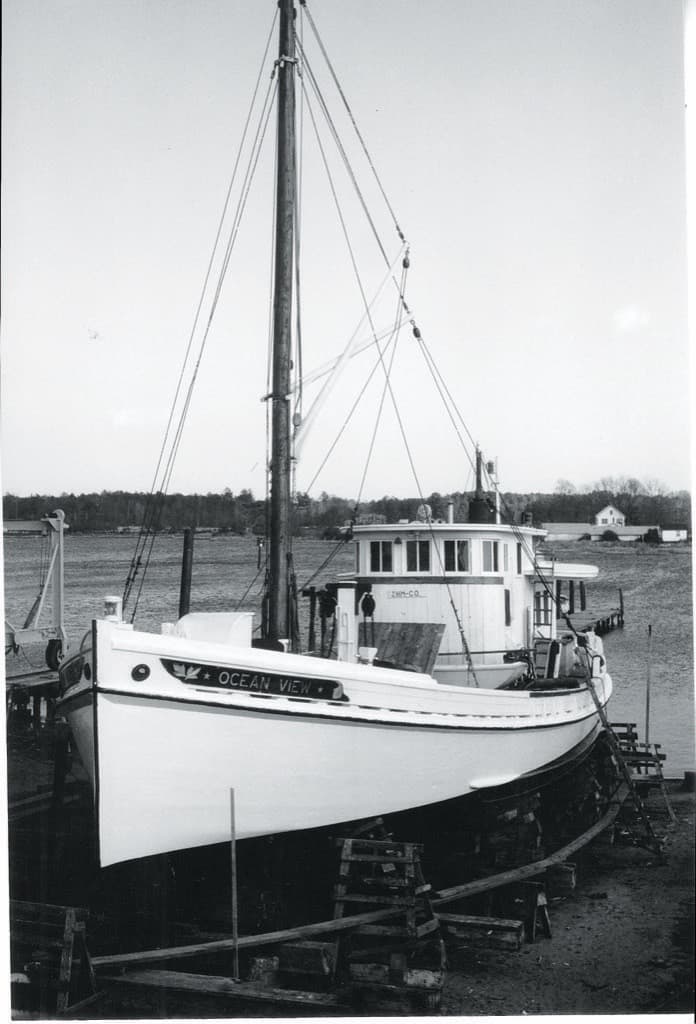
Mobjack & Ocean View
Mobjack is Coast Guard listed at 72.2’ x 24.6’ x 5.5’. The 72.2 feet is the keel length. She is over 80 feet long from stem-to-stern and is one of fewer than a dozen twentieth century buyboats built on the Bay over 80-feet long. There were hundreds of these boats built in the 55- to 65-foot range used to buy seafood and haul oysters, seed, and shell, but there were only a few really big ones. The reason, in part, was that at the turn of the twentieth century there was an abundance of large sailing vessels ideal for conversion to power. Many of these boats were over 80 feet long. Early on, it was more economical to convert large sailboats to power than to build big deadrise boats.
Over time, this changed. Mobjack was built in 1946 and Ocean View in 1949 by boatbuilders Linwood and Milford Price on Broad Creek in Deltaville for J. H. Miles Co. in Norfolk.
Miles was one of the largest oyster packing companies on Virginia’s lower bay. The firm leased nearly 8,000 acres of private oyster rock from the state, and its Norfolk shucking house had over 200 shuckers working during the oyster season. The firm grew, harvested, and processed thousands of bushels of oysters annually. “When oysters were good, the Miles family was like the coal barons. They were the Bay’s oyster barons,” said Green.
Mobjack and Ocean View were built at the end of World War II when the country was gearing up for an economic revival. Miles and other seafood dealers were optimistic the oyster business would take off again. The Miles family had been in the seafood business since before the turn of the twentieth century. They had seen ups and downs in the Bay’s oyster fishery. Business was always slow during wartime. With World War II over, the company gambled that things would be good again, and part of that gamble was to build Mobjack and her sister-ship, Ocean View.
Company officials knew exactly what they needed in a boat to work the shallow oyster grounds being leased on Mobjack Bay and the York and James Rivers. They also knew that boatbuilder Lin Price was an experienced boatbuilder and capable of building large, shallow draft, deadrise and cross-planked boats. Price had built the Marydel, the largest buyboat ever constructed on the Bay in 1927. She was over 100 feet long and built for the W. E. Valliant Co. of Delaware. The yard was well-equipped to build two 80-foot buyboats. The question was, could Price build an 80-foot boat, with 25 feet of beam, and five feet or so of draft that would hold 3,000 bushels of seed oysters?
In 1945, Miles hired naval architect and engineer Carl T. Forsberg of Freeport Long Island to design the flattest deadrise-bottom boat ever built on an 80-foot wooden buyboat. He was able to design the Mobjack and Ocean View with 5.5 feet of draft. “When the Mobjack came up for sale I knew she was exactly what I needed,” said Green. “I just wasn’t sure how much more life she still had in her. I was working some of the same shallow oyster grounds Mobjack and Ocean View had worked in the 1950s and 60s. The boats were built specifically to work some of the grounds I was leasing.”
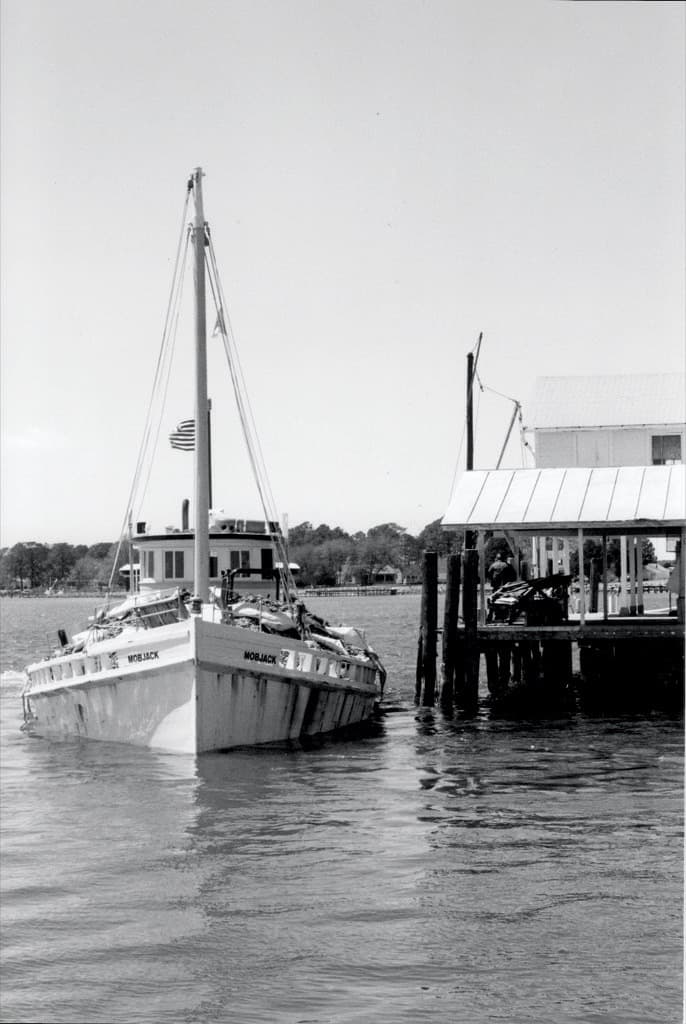
The Future
“It is great to see the business come back, but it is risky business,” said Green. “MSX and dermo killed millions of oysters and put almost everyone out of business. Oysters have come back though, with a lot of help from Virginia Institute of Marine Science and their work with disease-resistant oysters.”
“Right after Hurricane Hazel [in 1954] we couldn’t find enough oysters on James or York Rivers to make a bowl of oyster soup, but oysters came back, and the 1958-59 season was great.
“I have a lot of grounds where freshwater causes problems,” he said. “Oysters cannot stand but so much freshwater. Years when we have a lot of rain, I lost a lot of oysters. You just have to figure there are going to be good years and bad.”
Green figured there would be enough good years to justify rebuilding Mobjack and to buy Ocean View. He bought the Ocean View in 2012 from Bunky Chance of Talbot County, who had found the boat laid up in a shallow gut near Port Norris, New Jersey, and brought her back to the Chesapeake. He used her for a while planting seed and shells in the Maryland Department of Natural Resources’ Habitat Oyster Restoration project.
Asked about the future of the Ocean View, Green was silent for a moment, and then he said, “I don’t know. There was more rotten wood in the Mobjack when I started her than is in the Ocean View. She can be saved,” the 74-year-old said. “I kept my promise to Captain Jenkins that I would own her one day, but I’m not sure I’ve got enough time to bring her back to what she was when I was a boy.” h

